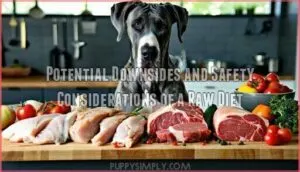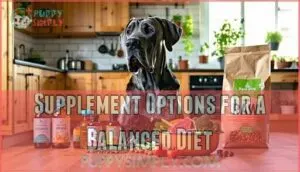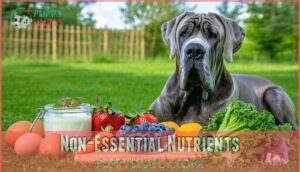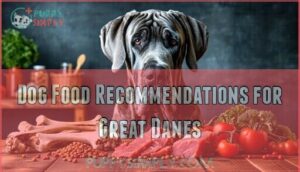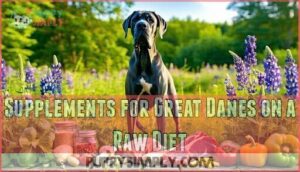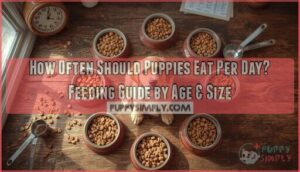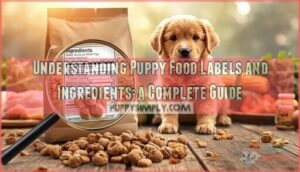This site is supported by our readers. We may earn a commission, at no cost to you, if you purchase through links.
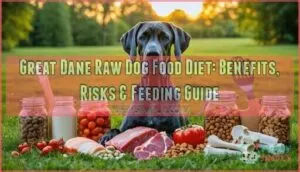
You’ll need to balance muscle meat, organs, and bones while watching for bacterial risks and ensuring proper nutrition.
The switch requires careful planning, especially for puppies who need specific ratios for healthy growth.
Most Great Danes adapt well to raw feeding, though some may experience initial digestive upset.
Cost and preparation time increase compared to kibble, but many owners find the health improvements worth the investment, and understanding proper ratios and safety protocols makes all the difference in success.
Table Of Contents
- Key Takeaways
- Benefits of a Raw Diet for Great Danes
- Potential Downsides and Safety Considerations of a Raw Diet
- Sample Raw Meal and Transitioning Tips
- Vegetables and Fruits in a Raw Diet
- Switching From Kibble to Raw Diet
- Debunking Myths of Great Dane Raw Diet
- Dog Food Recommendations for Great Danes
- Supplements for Great Danes on a Raw Diet
- Frequently Asked Questions (FAQs)
- Can Great Dane eat raw?
- What is a raw diet for Great Danes?
- What should a great dane eat?
- How much does a great dane eat a day?
- How do I know if my Great Dane eats raw food?
- Do Great Dane puppies need a specific diet?
- Why do vets say not to feed raw?
- How much does raw feeding cost monthly?
- Can senior Great Danes switch to raw?
- What freezer space is needed for storage?
- Conclusion
Key Takeaways
- You’ll see significant health improvements – shinier coats, better digestion, and stronger immunity when you feed your Great Dane a properly balanced raw diet with correct ratios of muscle meat, organs, and bones.
- You can switch immediately without a gradual transition – unlike other diet changes, you can move from kibble to raw food instantly, though you’ll need to monitor your dog’s adjustment and preferences during the first few weeks.
- You must prioritize food safety and proper ratios – handle raw meat carefully to prevent bacterial contamination, and follow precise guidelines (70-80% muscle meat, 10% bone, 5% liver, 5% other organs) to avoid nutritional imbalances.
- You’ll face higher costs but potentially fewer vet bills – raw feeding costs $90-240 monthly compared to kibble, but many owners report reduced veterinary expenses due to improved overall health and fewer diet-related issues.
Benefits of a Raw Diet for Great Danes
You’ll discover that switching your Great Dane to a raw diet can transform their health in remarkable ways, from shinier coats to stronger immunity.
The benefits extend beyond appearance, offering better digestion, weight control, and giving you complete knowledge of what’s fueling your gentle giant, with remarkable ways to improve their overall health.
Improved Coat and Skin Health
Switching to a great dane raw diet can dramatically transform your dog’s appearance. Raw nutrition provides essential fatty acids and proteins that create shiny coats and resolve persistent skin issues.
You’ll notice these coat care improvements:
- Reduced dog food allergies and skin irritation from processed ingredients
- Healthy fur that’s thicker and more lustrous than before
- Better hydration from raw food’s natural moisture content
Raw feeding great dane owners consistently report coat health improvements within weeks of switching from kibble. A well-planned raw diet should include omega 3 sources to promote healthy skin and a shiny coat.
Strengthened Immune System
Your Great Dane’s immune system acts like a fortress, and raw nutrition provides the strongest building blocks.
Raw feeding delivers natural immune boosters through unprocessed proteins, essential fatty acids, and bioavailable nutrients that support canine wellness.
This dietary balance strengthens your dog’s natural defenses against infections and diseases.
| Raw Diet Benefits | Immune System Impact |
|---|---|
| Natural enzymes | Enhanced pathogen resistance |
| Unprocessed nutrients | Stronger antibody production |
| Bioavailable vitamins | Improved cellular function |
Raw feeding great dane enthusiasts report fewer vet visits and better overall health outcomes through this immune system boost approach.
Weight Management
Raw diets offer natural calorie control for your Great Dane through nutrient-dense foods and proper portion sizes.
You’ll find that raw meat diet provides better satiety than kibble, helping prevent overeating.
The bone content raw diet naturally supports great dane weight management by requiring more energy to digest.
Smart diet planning with consistent feeding frequency makes obesity prevention straightforward.
Raw diet benefits include maintaining lean muscle while controlling fat storage, giving you confidence in your dog’s long-term health.
Reduced Feces Volume and Odor
You’ll notice your Great Dane’s waste becomes far more manageable on a raw diet.
Since raw food lacks unnecessary fillers and artificial additives found in processed kibble, your dog’s digestive system works more efficiently. This improved nutrient absorption creates a noticeable difference in stool quality and bathroom cleanup.
Here’s what you can expect:
- Smaller stools – Less waste volume means fewer cleanup sessions
- Reduced odor – Natural digestion eliminates harsh chemical smells
- Firmer consistency – Better-formed stools are easier to pick up
- Less frequent elimination – More nutrients absorbed means less waste produced
- Cleaner yard – Your outdoor space stays fresher longer
This feces reduction isn’t just convenient – it signals your Great Dane’s digestive health is improving dramatically.
Control Over The Dog’s Diet
One major advantage of great dane raw dog food diet is gaining complete owner involvement in your dog’s nutrition.
You control every ingredient, ensuring food quality meets your standards. Unlike commercial kibble, raw feeding allows customized meals suited to your Great Dane’s specific needs.
This hands-on diet planning approach lets you monitor nutrient balance carefully, adjusting portions and ingredients based on your dog’s response and health requirements.
Potential Downsides and Safety Considerations of a Raw Diet
While raw diets offer many benefits for Great Danes, they’re not without risks that you’ll need to carefully consider.
Understanding these potential downsides helps you make an informed decision about whether raw feeding is right for your gentle giant, and consider the potential benefits.
Harmful Bacteria in Raw Meat
While raw dog food diets offer benefits, they carry significant bacterial contamination risks that you can’t ignore.
Up to 70% of commercial raw meat products contain dangerous pathogens that threaten both your Great Dane and your family’s health.
Key bacterial contamination concerns include:
- Salmonella Risk – causes severe gastroenteritis and dehydration in dogs
- E Coli contamination found in 23-30% of raw dog food samples
- Food Poisoning from multi-drug resistant bacteria strains
- Raw Meat Safety requires specialized storage and handling protocols.
Proper food handling becomes your first line of defense against harmful bacteria.
Raw feeding guidelines emphasize thorough handwashing, separate preparation surfaces, and maintaining proper freezer temperatures to prevent bacterial growth in stored raw meat.
Concerns About Dietary Balance
Achieving balanced meals becomes complicated when you’re preparing raw recipes yourself.
Many homemade diets suffer from nutrient deficits, particularly calcium-phosphorus imbalances that can harm your Great Dane’s bone development.
Raw diet risks include missing vitamins, minerals, and proper nutrient ratios without careful planning.
Dog food malnutrition occurs when owners wing it instead of following proven formulations.
Dietary risks multiply if you don’t understand nutrient breakdown requirements.
A balanced diet demands precise measurements and variety over time, not guesswork that leaves gaps in your dog’s nutrition.
Ensuring a raw diet grain free approach requires careful consideration of nutritional components, including those found in raw diet benefits.
Risk of Diarrhea During Transition
Switching your Great Dane to raw feeding can trigger digestive distress as their system adapts.
**Your Great Dane’s digestive system needs time to adjust to this major dietary shift.
During this adaptation period, diarrhea causes include sudden dietary changes overwhelming gut bacteria and digestive enzymes struggling with new proteins.
Essential adaptation tips for managing digestive issues:
- Start slowly – Mix 25% raw with current food, increasing gradually over 7-14 days
- Add probiotics – Support gut health with beneficial bacteria supplements
- Include digestive enzymes – Help break down raw proteins more efficiently
- Monitor stool consistency – Track changes to identify potential raw diet risks
- Stay patient – Most dogs adjust within two weeks of consistent feeding
Inappropriateness for Certain Dogs
Raw diets aren’t suitable for every Great Dane, especially those with weak immune systems or specific health conditions.
Dogs with dietary restrictions or sensitivity issues require careful evaluation before switching from traditional dog food. Great Dane health depends on individual circumstances that may make raw food recipes inappropriate.
Consider these factors before starting:
- Compromised immunity – Dogs recovering from illness or with autoimmune disorders
- Specific allergies – Canines with known protein sensitivities or food intolerances
- Age-related concerns – Very young puppies or senior dogs with digestive challenges
Canine nutrition isn’t one-size-fits-all, and dog food risks vary by individual.
Potential Cost Considerations
One major financial hurdle you’ll face is the higher cost compared to kibble.
Raw ingredients typically cost 2-3 times more than commercial dog food, making budget planning essential for your Great Dane’s dietary expenses.
Cost Comparison & Financial Savings:
- Bulk buying from local butchers and suppliers can reduce costs by 20-40% while maintaining quality.
Smart cost management through strategic sourcing helps offset the premium price of feeding raw diets.
Sample Raw Meal and Transitioning Tips
Now that you’ve learned about the potential challenges of raw feeding, you’ll want to understand the practical aspects of creating balanced meals for your Great Dane.
Getting the ratios right and switching gradually can make the difference between success and digestive upset for your gentle giant, which is crucial for a gentle giant.
Ratios of Muscle Meat, Bone, Liver, and Other Organs
Your Great Dane’s great dane raw dog food diet needs precise nutrient proportions to thrive.
The muscle meat ratio should be 70-80%, providing protein and amino acids.
Bone ratio stays at 10% for calcium balance, while liver content remains at 5% maximum to prevent vitamin A toxicity.
Organ balance requires another 5% from kidney or spleen.
The prey model raw PMR follows 80/10/10 ratios, while BARF diet includes vegetables.
This organ meat raw diet foundation supports peak health.
Supplement Options for a Balanced Diet
Balancing your Great Dane’s raw diet requires strategic supplementation to fill nutritional gaps.
Most raw diets lack essential nutrients found in commercial formulations, making targeted supplements vital for peak great dane nutrition.
Key supplement categories include:
- Omega Fatty Acids & Joint Care: Fish oil provides omega3 fatty acids for coat health, while glucosamine supports joint function in large breeds
- Vitamin Boost & Mineral Support: Multivitamin supplements address deficiencies in vitamins D, E, and K, plus essential minerals like zinc and manganese
Consider adding probiotics for digestive health and dog food supplements containing green-lipped mussel or kelp for trace minerals.
Consult your veterinarian before introducing any supplements to confirm proper dosing and compatibility with your dog’s specific needs.
For superior results, owners should research dog supplements to find the best fit for their Great Dane’s unique requirements.
Feeding Guidelines for Puppies
Feeding your Great Dane puppy raw food isn’t rocket science, but it does require attention to detail. These gentle giants need proper puppy nutrition during their rapid growth stages, making feeding schedules and portions critical for healthy development.
Here’s your roadmap for raw introduction:
- Puppy portions: Feed 8-10% of body weight for 2-3 month old puppies, decreasing to 6-8% as they grow
- Growth stages: Adjust portions every 2-3 weeks based on weight and development milestones
- Great dane puppy diet: Include 22.5% protein and 8.5% fat minimum for proper growth
- Feeding raw great dane: Offer 3-4 meals daily for puppies under 6 months old
- Great dane nutrition: Balance muscle meat, organs, and raw meaty bones appropriate for their size
Your great dane diet plan should prioritize consistent feeding schedules while monitoring weight gain. A well-planned raw dog feeding approach is essential for their overall health and development.
Transitioning Tips for a Smooth Switch
Switching your Great Dane to raw requires patience and careful planning.
Start with easily digestible proteins like chicken, then gradually introduce richer meats over several weeks.
This gradual switch helps prevent digestive upset and allows your dog’s system to adapt properly.
- Begin slowly: Replace 25% of kibble with raw every few days during the switch period
- Monitor closely: Watch for loose stools or appetite changes as indicators of how well they’re adapting
- Stay consistent: Maintain regular feeding schedules and avoid rapid switches that could cause stomach issues
Vegetables and Fruits in a Raw Diet
While vegetables and fruits aren’t essential for your Great Dane’s raw diet, they can provide beneficial nutrients and variety when added safely.
You’ll need to know which produce to avoid and how to prepare these additions properly for your dog’s digestive system.
Non-Essential Nutrients
While your Great Dane thrives on meat, vegetables and fruits aren’t essential but offer valuable bonus nutrition.
These plant additions provide antioxidants, phytochemicals, and fiber sources that support digestive health. You’ll find probiotics in unsweetened yogurt, omega fats in whole eggs, and nutrients in raw green tripe.
| Beneficial Additions | Nutritional Value |
|---|---|
| Blueberries & Carrots | Antioxidants & Fiber |
| Unsweetened Yogurt | Probiotics & Calcium |
| Whole Eggs | Omega Fats & Protein |
| Raw Green Tripe | Probiotics & Enzymes |
Introduce these slowly—your dog’s digestive system needs time to adjust to new foods.
Toxic Foods to Avoid
While vegetables and fruits offer beneficial nutrients, certain foods pose serious health risks for your Great Dane.
Onion toxicity can destroy red blood cells, causing life-threatening anemia. Grape danger includes acute kidney failure, even from small amounts. Chocolate poisoning affects the heart and nervous system, while caffeine risks mirror chocolate’s deadly effects. The xylitol threat causes rapid blood sugar drops and liver failure.
Never feed these toxic foods:
- Onions – Raw, cooked, or powdered forms cause hemolytic anemia
- Grapes – Any amount can trigger fatal kidney failure
- Avocado – Pits create choking hazards; flesh causes digestive upset
- Raw potatoes – Green potatoes contain harmful solanine compounds
It’s essential to understand toxic dog foods to keep your Great Dane safe.
Introducing New Ingredients Gradually
Introducing your Great Dane to new foods doesn’t have to feel like traversing a minefield. Gradual introduction protects your pup’s digestive health while expanding their prey model raw (PMR) options.
Start with one new ingredient per week, allowing their system to adjust before adding another.
| Week | New Ingredient | Serving Size |
|---|---|---|
| 1 | Carrots (chopped) | 1-2 tablespoons |
| 2 | Sweet potato | 2-3 small pieces |
| 3 | Blueberries | 5-8 berries |
| 4 | Green beans | 3-4 pieces |
Monitor your dog’s response during each dog food switch. Loose stools or reluctance to eat signals you’re moving too fast.
Ingredient rotation prevents food sensitivities while ensuring dietary variety. Remember, patience pays off—rushing new foods can upset their stomach and set back your great dane raw dog food diet progress.
Cooking or Chopping Vegetables for Improved Digestion
Raw vegetables can be tough on your Great Dane’s digestive system since dogs lack certain digestive enzymes to break down plant cell walls effectively.
Smart vegetable prep makes all the difference for nutrient absorption and gut health.
Vegetable Prep Methods for Better Dog Digestion:
- Chop finely – Breaking down cell walls mechanically aids natural dog food processing
- Light steaming – Softens fibers while preserving nutrients in homemade dog food
- Puree raw – Creates easily digestible consistency for sensitive stomachs
- Freeze and thaw – Natural process breaks down cellular structure for raw food safety
Proper preparation transforms tough vegetables into digestible nutrition. Your dog’s digestive system will thank you, and you’ll maximize the benefits of raw dog food while supporting ideal dog food digestion and overall gut health.
Switching From Kibble to Raw Diet
Making the switch from kibble to raw food doesn’t require a gradual adjustment period like you might expect with other dietary changes.
You can switch your Great Dane immediately, though you’ll want to monitor how they adjust to their new meals and note any preferences they develop for certain proteins or textures, which can be a complete process to understand their new needs.
No Transition Period
Unlike many adult great dane diet changes, switching to the best raw dog food doesn’t require weeks of careful planning.
You can make a cold turkey, instant switch from kibble to prey model raw PMR without gradual adjustments.
This sudden change won’t cause digestive upset like traditional dog food changeover methods suggest, because your Great Dane’s system adapts quickly to natural foods, making this great dane feeding guide approach both simple and effective.
Monitoring Dog’s Adjustment and Preferences
Once your Great Dane starts their raw dog food diet, watch closely for signs they’re adapting well.
Dog health checks become your best friend during adjustment periods.
- Monitor stool quality: Loose stools are normal initially, but persistent diarrhea signals raw food intolerance
- Track energy levels: Notice if your pup seems more energetic or sluggish than usual
- Observe eating habits: Some dogs develop strong dog food preferences for certain proteins in their prey model raw PMR meals
Keeping feeding schedules consistent helps your Great Dane’s digestive system adjust smoothly.
Your great dane feeding guide should include notes about which foods they love most—this helps with canine nutrition planning ahead.
Debunking Myths of Great Dane Raw Diet
You’ll encounter plenty of myths about raw feeding that can create unnecessary worry or confusion.
These misconceptions often stem from outdated information or misunderstandings about proper raw diet practices for Great Danes.
Addressing Concerns About Microbial Presence
Despite common fears about microbial risks, you don’t need to panic about bacterial contamination in raw meat for Great Danes.
Here’s what actually matters for raw safety:
- Your dog’s digestive system naturally handles bacteria – their stomach acid is much stronger than humans’, effectively neutralizing most pathogens like Salmonella
- Proper food handling prevents most issues – wash hands, clean surfaces, and store meat correctly
- Quality sourcing matters more than sterilization – choose reputable suppliers who test for contamination
- Pathogen prevention starts with you – maintain good hygiene during raw meat handling and preparation
The key points emphasize the importance of proper handling, quality sourcing, and the natural defenses of your dog’s digestive system in ensuring raw meat safety.
Safety of Raw Bones
Many dog owners worry needlessly about raw bones causing harm to their Great Danes.
When you choose appropriate bones and follow proper Raw Feeding guidelines, Bone Safety becomes manageable.
Raw bones don’t splinter like cooked ones, reducing Dental Risks substantially.
However, size matters—avoid weight-bearing bones from large animals that could create Choking Hazards or Digestive Issues.
Select softer options like chicken necks or ribs.
Always supervise feeding sessions and maintain proper raw meat handling practices to minimize microbial presence and bacteria concerns while ensuring your Dane’s safety.
Suitable Types of Bones for a Raw Diet
Choosing the right bones for your Great Dane’s organ meat raw diet requires understanding bone density and size requirements.
Not all bones work safely for these gentle giants.
Recreational bones provide mental stimulation and dental benefits, while edible bones supply essential calcium.
Your Great Dane needs supervised chewing sessions to prevent accidents.
Safe bone options include:
- Beef knuckle bones – Perfect size for powerful jaws
- Turkey necks – Softer density for easy consumption
- Lamb ribs – Appropriately sized recreational bones
- Fish frames – Calcium-rich edible bones
- Beef tails – Manageable size with good marrow content
Avoid weight-bearing leg bones that can crack teeth or cause blockages.
Dog Food Recommendations for Great Danes
Choosing the right food for your Great Dane can feel overwhelming with countless options lining pet store shelves.
Whether you’re considering high-quality kibble or making the switch to raw feeding, understanding your options helps you make the best decision for your gentle giant’s health and happiness.
Dry Dog Foods (Kibble)
While raw diets get lots of attention, kibble remains a practical choice for many Great Dane owners.
You’ll find quality dry dog foods that meet your gentle giant’s nutritional needs without the difficulties of raw feeding.
Top kibble brands for Great Danes include Diamond Naturals, Fromm Family Foods, and Holistic Select.
These manufacturers follow strict quality standards and offer formulations specifically designed for large breed dogs.
When selecting kibble, consider your Great Dane’s specific needs:
- Peace of mind: Quality kibble undergoes rigorous testing and consistent manufacturing processes
- Convenience: No prep time, extended shelf life, and easy portion control
- Safety: Reduced risk of bacterial contamination compared to raw diets.
Kibble nutrition varies substantially between brands, so read ingredient lists carefully.
Look for whole proteins as the first ingredient and avoid foods with excessive grain content or frequent food recalls.
Some Great Danes develop dog allergies to certain proteins or grains, making ingredient transparency vital.
The manufacturing process guarantees consistent nutrient levels, though it does reduce some natural enzymes found in fresh foods.
Raw Feeding Recommendations
When selecting raw feeding recommendations for your Great Dane, focus on hormone-free meats and meaty bones while avoiding weight-bearing options.
A BARF (Biologically Appropriate Raw Food) approach guarantees proper nutrient balance through raw diet planning. Feed approximately 3% of your dog’s healthy weight, adjusting as needed.
Skip Pacific Salmon and Sea Trout due to parasite risks. These feeding guidelines support maximum canine nutrition and raw meat safety for your gentle giant.
For a balanced diet, consider raw dog food options that meet your dog’s nutritional needs.
Supplements for Great Danes on a Raw Diet
While your Great Dane thrives on a raw diet, strategic supplementation guarantees they’re getting complete nutrition. Raw feeding naturally provides many nutrients, but certain gaps might need attention.
Consider these key supplements for peak health:
- Joint Care Support: Glucosamine and chondroitin help maintain healthy cartilage, especially vital for large breeds prone to hip issues. Green-lipped mussel extract offers natural anti-inflammatory benefits that keep joints moving smoothly.
- Digestive Aid: Probiotics support gut health during dietary shifts and maintain balanced intestinal flora. Raw diets retain natural digestive enzymes, but additional support helps nutrient absorption.
- Omega Fatty Acids: Fish oil provides essential EPA and DHA for coat shine, joint health, and immune function. These aren’t always adequate in muscle meat alone.
Your vet can recommend specific dosages based on your dog’s size and health status. Remember, quality raw diets with organ meats, eggs, and fish often provide natural vitamin boosts, making targeted supplementation more effective than blanket multivitamins. A well-planned raw diet includes raw food benefits that promote overall health and wellness.
Frequently Asked Questions (FAQs)
Can Great Dane eat raw?
Like knights of old protecting their kingdom, you can feed your Great Dane raw food, but proceed with caution.
Raw diets offer benefits like improved coat health and digestion, yet carry risks including bacterial contamination and nutritional imbalances that require careful planning.
What is a raw diet for Great Danes?
You’ll feed your Great Dane uncooked muscle meat, raw bones, organs, and vegetables following specific ratios. This diet mimics their natural eating habits while requiring careful balance and safety precautions.
What should a great dane eat?
You’d laugh thinking your gentle giant needs gourmet meals, but Great Danes actually thrive on balanced nutrition that supports their massive frames and prevents bloat-related health issues.
How much does a great dane eat a day?
Adult Great Danes typically eat 6-10 cups of food daily, split into two meals.
You’ll need to adjust portions based on your dog’s weight, activity level, and metabolism to maintain their ideal body condition.
How do I know if my Great Dane eats raw food?
You’ll notice firmer, smaller stools with less odor, shinier coat, cleaner teeth, and increased energy levels.
Your Great Dane’s digestion improves substantially, and they’ll show fewer allergic reactions compared to kibble-fed dogs, which can lead to a noticeable difference in their overall health, with increased energy levels.
Do Great Dane puppies need a specific diet?
A growing German Shepherd puppy tripled in size within six months on the wrong diet, developing painful joint problems.
Yes, Great Dane puppies need specific nutrition – they require higher protein (5%) and fat (5%) than adults to support proper growth without bone developmental issues, which is crucial for their proper growth.
Why do vets say not to feed raw?
Vets worry about bacterial contamination from pathogens like salmonella and E. coli, nutritional imbalances that can harm your dog’s health, and choking hazards from bones that might cause serious injuries.
How much does raw feeding cost monthly?
Raw feeding costs $3-8 per day for Great Danes, totaling $90-240 monthly. You’ll pay more than kibble, but many owners find reduced vet bills offset expenses over time.
Can senior Great Danes switch to raw?
Like teaching an old dog new tricks, switching your senior Great Dane to raw food isn’t impossible but requires careful consideration.
You’ll need veterinary guidance, gradual introduction, and close monitoring since older dogs have sensitive digestive systems and potential health conditions.
What freezer space is needed for storage?
You’ll need approximately 10-15 cubic feet of freezer space for a Great Dane’s monthly raw food supply. That’s roughly equivalent to a standard chest freezer or large upright freezer compartment.
Conclusion
Like choosing the right fuel for a high-performance engine, your Great Dane raw dog food diet decision requires careful consideration of your dog’s individual needs and your commitment level.
Raw feeding isn’t a magic solution, but it can offer significant benefits when executed properly.
You’ll need to balance the improved coat quality and digestive health against potential bacterial risks and increased preparation time.
Success depends on understanding proper ratios, maintaining food safety protocols, and monitoring your Great Dane’s response throughout the adaptation process.
- https://petcubes.com/blogs/supplements-for-raw-diet/what-to-add-to-dog-food
- https://www.prodograw.com/raw-feeding-guide/great-dane-feeding-guide/
- https://tryrawcube.com/blogs/a-guide-to-raw-feeding-models-barf-vs-pmr/common-nutrient-deficiencies-and-toxicities-in-raw-dog-food-diets
- https://rawfedk9.com/products/nutra-boost
- https://omni.pet/blogs/news/raw-dog-food-diet-guide

